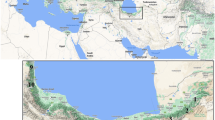Summary
Allozyme variation was examined in 22 populations of Pinus densiflora (Sieb, et Zucc.) and four geographic varieties of P. sylvestris (L.): var ‘lapponica’ (Fries, Hartman), var ‘armena’ (Komarov), var ‘mongolica’ (Litvinov) and var ‘sylvestriformis’ (Takenouchi). In addition, we developed paternal chloroplast (cp) DNA markers that distinguish P. densiflora from var ‘lapponica’, var ‘armena’ and var ‘mongolica’. UPGMA cluster analysis based on Nei's distances between all pairwise combinations of the 22 populations revealed patterns corresponding strictly to geographic origin and taxonomic status. Analysis of allozyme variation in var ‘lapponica’, var ‘armena’ and var ‘mongolica’ demonstrated a high level of intrapopulational variability but a low level of interpopulational differentiation. It appears that the late Pleistocene blending of genetically diverse populations was responsible for the observed variation patterns. The constructed phylogenetic trees also showed late divergence of these three varieties. The var ‘sylvestri formis’ was genetically distinct from the other three P. sylvestris varieties. The genetic distances separating var ‘sylvestriformis’ from P. densiflora and the other taxa lend support to a separate taxonomic status for var ‘sylvestriformis’ and a close relation with P. densiflora. We found that var ‘sylvestriformis’ harbors admixtures of allozymes and cpDNA from both P. sylvestris and P. densiflora, which suggests an introgressive nature of this variety. Levels of intrapopulational variability were similar in P. sylvestris and P. densiflora, but interpopulational differentiation was much higher in P. densiflora. In the constructed phylogenetic trees, populations of this species were characterized by relatively long internode distances and branch lengths. The present results suggest that P. densiflora has a more advanced evolutionary age than P. sylvestris.
Similar content being viewed by others
References
Boratyński A (1991) Range of natural distribution. In: Giertach M, Mátyás C (eds) Genetics of Scots pine. Akadémiai Kiadó, Budapest, pp 19–30
Cavalli-Sforza LL, Edwards AWF (1967) Phylogenetic analysis: models and estimation procedures. Evolution 21:550–570
Cheng W-C, Fu L-G (1978) Chinese flora. Sci Press 7:203–280 (in Chinese)
Cheng W-C, Fu L-K, Cheng C-Y (1975) Gymnospermae sinicae. Acta Phytotaxon Sinica 13:56–89 (in Chinese)
Elston RC (1971) The estimation of admixture in racial hybrids. Ann Hum Genet 35:9–17
Farris JS (1972) Estimating phylogenetic trees from distance matrices. Am Nat 106:645–668
Giertych M (1991) Provenance variation in growth and phenology. In: Giertych M, Mátyás C (eds) Genetics of Scots pine. Akadémiai Kiado, Budapest, pp 87–101
Kimura M (1982) Molecular evolution, protein polymorphism and evolutionary theory. Japan Scientific Societies Press, Tokyo
Kosiński G (1991) Hybridization. In: Giertych M, Mátyás C (eds) Genetics of Scots pine. Akadémiai Kiadó, Budapest, pp 183–189
Lidholm J, Gustafsson P (1991) The chloroplast genome of the gymnosperm Pinus contorta: a physical map and a complete collection of overlapping clones. Curr Genet 20:161–166
Miller JC (1991) Restsite: a phylogenetic program that sorts raw restriction data. J Hered 82:262–263
Mirov NT (1967) The genus Pinus. The Ronald Press Company, New York
Molotkov PI, Patlaj IN (1991) Systematic position within the genus Pinus and intraspecific taxonomy. In: Giertych M, Mátyás C (eds) Genetics of Scots pine. Akadémiai Kiadó, Budapest, pp 31–39
Muona O (1990) Population genetics in forest tree improvement. In: Brown AHD, Clegg MT, Kahler AL, Weir BS (eds) Population genetics, breeding and genetic conservation. Sinauer, Sunderland, Mass., pp 282–298
Nei M (1987) Molecular evolutionary genetics. Columbia University Press, New York
Palmer JD, Shields CR, Cohen DB, Orton TJ (1983) Chloroplast DNA evolution and the origin of amphidiploid Brassica species. Theor Appl Genet 65:181–189
Ritland K, Eckenwalder JE (1992) Polymorphism, hybridization, and variable evolutionary rate in molecular phylogenies. In: Soltis PL, Soltis DE, Doyle JJ (eds) Molecular systematics of plants. Chapman and Hall, New York London, pp 404–428
Roberts DF, Hiorns RW (1965) Methods of analysis of the genetic composition of hybrid population. Hum Biol 37:38–43
Ruby JL, Wright JW (1976) A revised classification of geographic variation in Scots pine. Silvae Genet 25:169–175
Saitou N, Nei M (1987) The neighbor-joining method: A new method for reconstructing phylogenetic trees. Mol Biol Evol 4:406–425
Sneath PH, Sokal RR (1973) Numerical taxonomy. Freeman and Co, San Francisco
Son D, Hong S, Yeo J, Ryu J (1989) Genetic variation of isozymes in populations of Pinus densiflora and Pinus thunbergii naturally distributed in Kyungpook province. J Korean For Soc 78:345–359
Swofford DL (1981) On the utility of the distance Wagner procedure. Advances in cladistics. In: Funk VA, Brooks DR (eds) Proc 1st Meeting Willie Hennig Soc. New York Botanical Garden, Bronx, New York, pp 25–43
Swofford DL, Seiander RB (1981) BIOSYS-1: a FORTRAN program for the comprehensive analysis of electrophoretic data in population genetics and systematics. J Hered 72:281–283
Szmidt AE (1984) Genetic studies of Scots pine (Pinus sylvestris L.) domestication by means of isozyme analysis. PhD thesis, The Swedish University of Agricultural Sciences, Umeå, Sweden
Szmidt AE (1991) Phylogenetic and applied studies on chloroplast genome in foret conifers. In: Fineschi S, Cannata F, Hattemer HH (eds) Biochemical markers in the population genetics of forest trees. SPB Academic Publ, The Hague, the Netherlands, pp 185–196
Szmidt AE, Lidholm J, Hallgren J-E (1986) DNA extraction and preliminary characterization of chloroplast DNA from Pinus sylvestris and Pinus contorta. In: Lindgren D (ed) Proc of the Frans Kempe Symp Provenances Forest Tree Breed for High Latitudes. Umeå, pp 269–280
Takenouchi M (1942) A preliminary report on the conifers of Manchukuo. J Jpn For Soc 24:113–129
Wang X-R, Szmidt AE (1990) Evolutionary analysis of Pinus densata (Masters), a putative Tertiary hybrid. 2. A study using species-specific chloroplast DNA markers. Theor Appl Genet 80:641–647
Wang X-R, Szmidt AE, Lindgren D (1991) Allozyme differentiation among populations of Pinus sylvestris L. from Sweden and China. Hereditas 114:219–226
Wheeler NC, Guries RP (1987) A quantitative measure of introgression between lodgepole and jack pines. Can J Bot 65:1876–1885
Author information
Authors and Affiliations
Additional information
Communicated by P.M.A. Tigerstedt
Rights and permissions
About this article
Cite this article
Szmidt, A.E., Wang, X.R. Molecular systematics and genetic differentiation of Pinus sylvestris (L.) and P. densiflora (Sieb. et Zucc.). Theoret. Appl. Genetics 86, 159–165 (1993). https://doi.org/10.1007/BF00222074
Received:
Accepted:
Issue Date:
DOI: https://doi.org/10.1007/BF00222074



